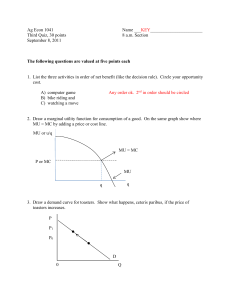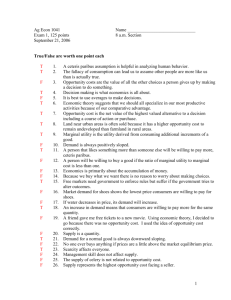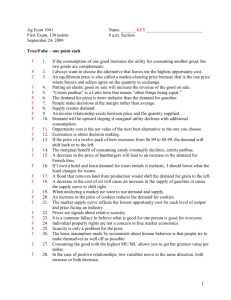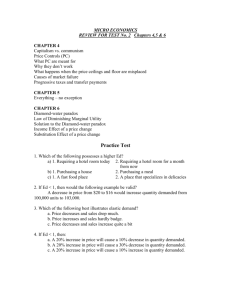Exam 1d
advertisement
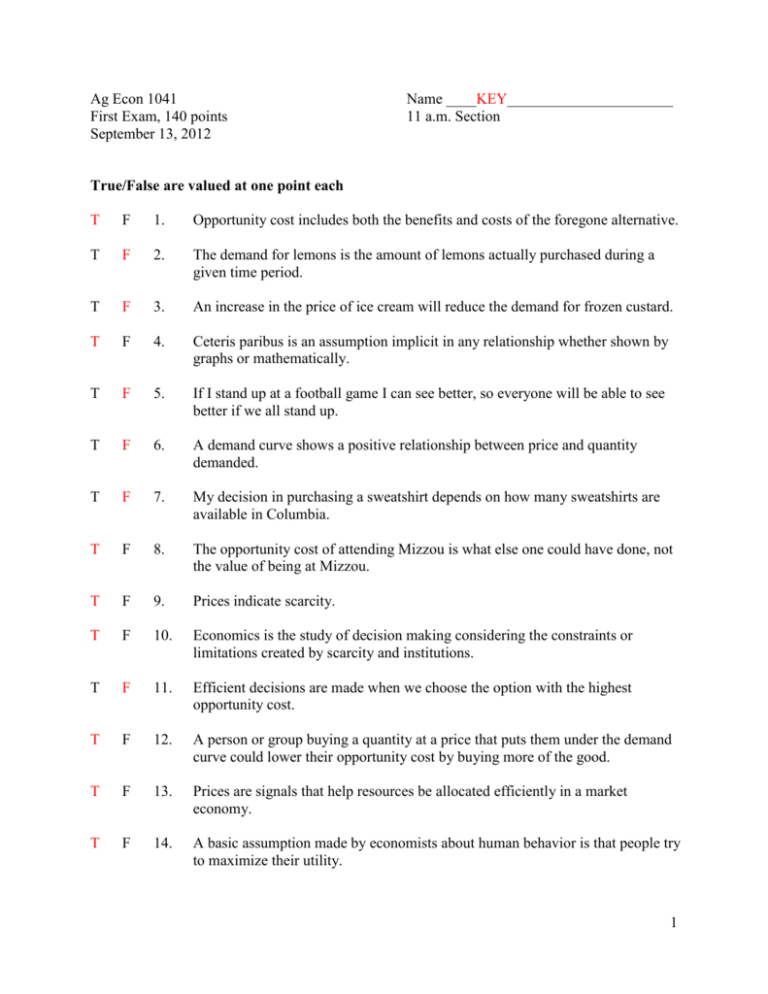
Ag Econ 1041 First Exam, 140 points September 13, 2012 Name ____KEY______________________ 11 a.m. Section True/False are valued at one point each T F 1. Opportunity cost includes both the benefits and costs of the foregone alternative. T F 2. The demand for lemons is the amount of lemons actually purchased during a given time period. T F 3. An increase in the price of ice cream will reduce the demand for frozen custard. T F 4. Ceteris paribus is an assumption implicit in any relationship whether shown by graphs or mathematically. T F 5. If I stand up at a football game I can see better, so everyone will be able to see better if we all stand up. T F 6. A demand curve shows a positive relationship between price and quantity demanded. T F 7. My decision in purchasing a sweatshirt depends on how many sweatshirts are available in Columbia. T F 8. The opportunity cost of attending Mizzou is what else one could have done, not the value of being at Mizzou. T F 9. Prices indicate scarcity. T F 10. Economics is the study of decision making considering the constraints or limitations created by scarcity and institutions. T F 11. Efficient decisions are made when we choose the option with the highest opportunity cost. T F 12. A person or group buying a quantity at a price that puts them under the demand curve could lower their opportunity cost by buying more of the good. T F 13. Prices are signals that help resources be allocated efficiently in a market economy. T F 14. A basic assumption made by economists about human behavior is that people try to maximize their utility. 1 T F 15. The true cost of something is what you give up for it. T F 16. The opportunity cost of a decision is the best alternative choice to the one you made. T F 17. Incentives affect our decision making. T F 18. The marginal benefit of a good to the buyer must exceed the marginal cost if a purchase is to occur. T F 19. Demand is a relationship between the price of a good and the quantity of the good consumers want and are able to buy. T F 20. A decrease in price suggests the good is become scarcer. T F 21. A change in demand is illustrated by a new demand curve. T F 22. Efficient decisions are made at the margin rather than being based on an average. T F 23. Trade is made easier with the use of money. T F 24. The opportunity cost of a purchase is never more than the price paid for the good. T F 25. A decline in the price of vanilla ice cream will increase the demand for vanilla ice cream. T F 26. When making decisions we face various constraints that can include income, time or others. T F 27. Demand is the aggregation of individuals’ decisions made following the decision rule. T F 28. The demand for sunscreen will increase now that autumn has arrived. T F 29. Marginal utility will always eventually diminish, ceteris paribus, as consumption increases. T F 30. Demand is downward sloping due to the income and substitution effects as well as diminishing marginal utility. 2 Multiple choice are valued at two points each __C___ 31. The amount of satisfaction gained from purchasing an additional pair of jeans is a) Total utility b) Determined by one’s income level c) Marginal utility d) A result of the decision rule e) Never negative __B___ 32. The law of demand states that the quantity demanded declines, ceteris paribus, if a) Price of another good changes b) Price of this good rises c) Income changes d) Expectations change e) None of the above __D___ 33. Which of the following is a goal for everyone? a) Public welfare b) Profit c) Lowest cost d) Utility maximization e) None of the above __A___ 34. Suppose the Chicago Enforcers football team lowers ticket prices by 21% and as a result the quantity of tickets demanded increases by 12%. This response means that the demand for the Enforcers’ tickets is a) Inelastic b) Unit elastic c) Elastic d) Irrelevant e) Undefined __E___ 35. Which of the following will cause an increase of the demand curve for new cars? a) An increase in consumer incomes b) Consumer expectations that the price of new cars will be higher next year c) Low quality and high price of public transportation d) A decrease in the price of gasoline e) All of the above __C___ 36. Which of the following will cause a decrease in the demand for smart phones? a) An increase in consumer incomes b) An increased preference for the versatility of smart phones c) An expectation that smart phones will decrease in the price next year d) Improved reception of smart phones e) All of the above 3 __C___ 37. Which of the following causes demand to be more elastic with respect to price? a) Shorter periods of time to adjust to a change in price b) Very low price relative to income c) Many substitutes d) An asteroid sighting e) Little time to make a decision __C___ 38. People find it difficult to get along without necessities, therefore demand for necessities: a) Is relatively elastic b) Is unitary elastic c) Is relatively inelastic d) Does not change with changes in price e) None of the above __B___ 39. The quantity demanded (not demand as a whole) will increase in response to a) Higher costs of production b) Lower price of the good c) Lower income d) A decrease in the number of buyers e) None of the above __D___ 40. As we eat more of a food, eventually the extra consumption causes the following to occur a) The law of diminishing total utility b) The law of supply c) A shift in demand d) The law of diminishing marginal utility e) None of the above 4 Matching are valued at one point each M 41. Own-price elasticity A. Nothing else changing Q 42. Demand B. True cost of a decision E 43. Incentives C. Study of resource allocation and decision making G 44. Consumer goal D. Net value consumers receive from a good R 45. Income elasticity E. Effort to change behavior J 46. Utility F. Edge, where change occurs F 47. Margin G. Maximize utility given income constraint A 48. Ceteris paribus H. Positive for substitutes P 49. Total revenue I. Believing something is true for everyone H 50. Cross price elasticity J. Value, benefit or satisfaction D 51. Consumer surplus K. Demand is positively related to income change T 52. Inelastic demand L. What matches a particular price B 53. Opportunity cost M. Responsiveness of quantity demanded to price N 54. Complement N. Best when consumed with another product K 55. Normal good O. Potential replacement for a good bought I 56. Fallacy of composition P. Sum of marginal utility for amount consumed L 57. Quantity demanded Q. Price-quantity relationship of consumers C 58. Economics R. Demand shift measure related to income S 59. Decision rule S. Approach consumers use to maximize utility O 60. Substitute T. Qd not very responsive to price change 5 Short answers are valued at five points each 61. What do we call the benefits and costs of the best foregone alternative? Opportunity cost 62. What is it called if you have a lower opportunity cost than another person? Comparative advantage 63. List these three activities in order of net benefit (like the decision rule). Circle your opportunity cost. Computer game; bike riding; watching a movie. a. Any order. Circle B b. c. 64. Draw a demand curve for toasters. Show what happens, ceteris paribus, if the price of toasters increases. $/Q P1 P0 D 0 Q1 Q0 Q 65. Decisions are made at the __margin________________________. 6 66. If ramen noodles are an inferior good in the market, diagram the impact of an increase in income. P D1 D0 0 Q 67. If the quantity demanded increases at a smaller percentage than the price of a good falls, then demand is said to be ___inelastic______________________. 68. The price of bottled water is $2/liter and the price of chocolate milk is $1.50/liter. Why does Melanie consume more water than milk? MU w > MU m $2 $1.5 69. What do we call the net benefit buyers receive from buying MU football tickets? Consumer surplus 70. If demand is elastic then the elasticity coefficient is ____> 1______________ and marginal revenue is __positive___________________________. 71. Identify the type of good a) Ey > 0 __normal_______________ b) Eij < 0 __complement_______________ c) Buy because income is low ___inferior______________________ d) Consumed with other goods __complement_________________ 7 72. Diagram the situation for a single good when deciding how much to purchase. u/q MU q* is amount to purchase MC 0 q* q The following question is valued at 10 points 73. Given the following information about utility, list the order in which the two goods are consumed as David spends all of his $10. The price of soda is $2 and the price of pizza is $3. Quantity consumed Marginal Utility of Pizza Marginal Utility of Soda 1 30 18 2 21 16 3 15 12 4 6 6 5 0 2 Order of consumption (pizza or soda) 1. 2. 3. 4. 5. ___pizza___________ ___soda____________ ___soda____________ ___pizza___________ _______________ 8
